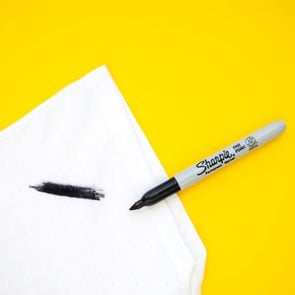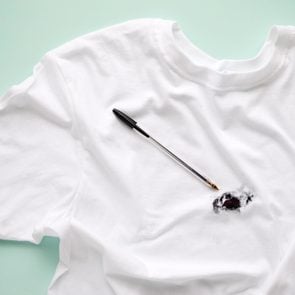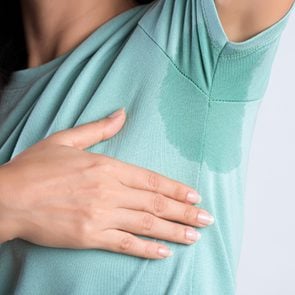How to Clean Leather and Protect It for Long-Lasting Results
Updated: Apr. 24, 2024
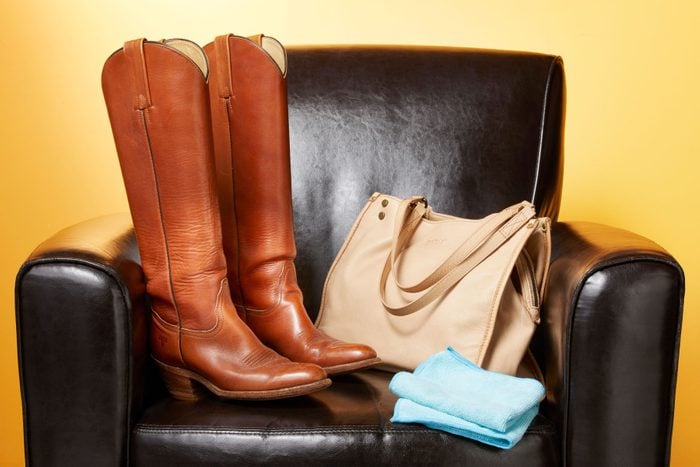
For a supple, smooth finish and long-lasting protection, follow these expert-recommended methods for how to clean leather
I’ve been cleaning my leather all wrong, and I should know better. In addition to various leather accessories, such as wallets, belts and handbags, we have two leather sofas. As is the case with many people, our leather sofas, purchased because of their durability, are the most expensive items of furniture we own. Leather is tough and strong and can last decades, but it requires gentle cleaning and treatment. And unfortunately, I haven’t spent enough time learning how to clean leather.
The cleaning world is rife with shortcuts, tips and hacks. The temptation to cut down on our cleaning time with quick-and-easy tasks is understandable—who wants to spend all their time learning how to clean, after all? I’ve even tried a certain TikTok hack involving a dishwasher tablet and a pot lid on my leather couch. (I’m ashamed to admit it, and I now know that dishwashing detergent is far too harsh for leather.)
All shortcuts aside, I needed to learn how to clean leather properly. In my quest, I spoke to three leather-care experts—and something shifted. Their advice reminded me that we need to care for our possessions not merely so we can check off a cleaning checklist, but so we can acknowledge the items that serve us in our homes. Appreciate the material. Take in the smell. Slow down. This slight perspective adjustment transformed a chore into a meditative sensory experience. Taking care of our possessions can be a way to take care of the people who use them. The act of caring for my leather furniture, I realized, can help take care of me. So here’s what I learned.
Get Reader’s Digest’s Read Up newsletter for more cleaning, humor, travel, tech and fun facts all week long.
About the experts
Reviewed for accuracy by: Mary Marlowe Leverette, a highly regarded fabric-care, stain-removal and housekeeping expert with more than 40 years of experience. |
On This Page
What’s the best way to clean leather?
When it comes to cleaning leather, less is always more. There are many different types of leather and leather finishes, but most leathers you’ll deal with at home will respond well to cleaning with water, mild solutions you can make at home or specific leather-care products.
You’ll want to start out with the most mild cleaning technique first, which happens to be a damp rag (not saturated). “It never hurts to take a damp washcloth and wipe something off with water,” says Bruce Gershon, the owner and operator of Arrow Leathercare Services, who has been cleaning leather for 50 years. If that doesn’t work or for dirtier leather, you can work your way up to an extremely mild cleaning solution of dish soap and water, baby shampoo and water, or vinegar and water to wipe down your leather. Another great option is to use a leather cleaner.
The exceptions to the above are suede (a type of leather made from the underside of the animal skin) and untreated leather, which require extra precautions (more on that below). And remember: You don’t have to clean your leather by yourself! If you’re wary of damaging your leather pieces, you want to remove a tough stain or you just want professional-grade leather care, send your items to the professionals who have the knowledge, experience, products and equipment to handle your item.
No matter which method you choose, always spot test the leather you’re cleaning in order to avoid unpleasant surprises.
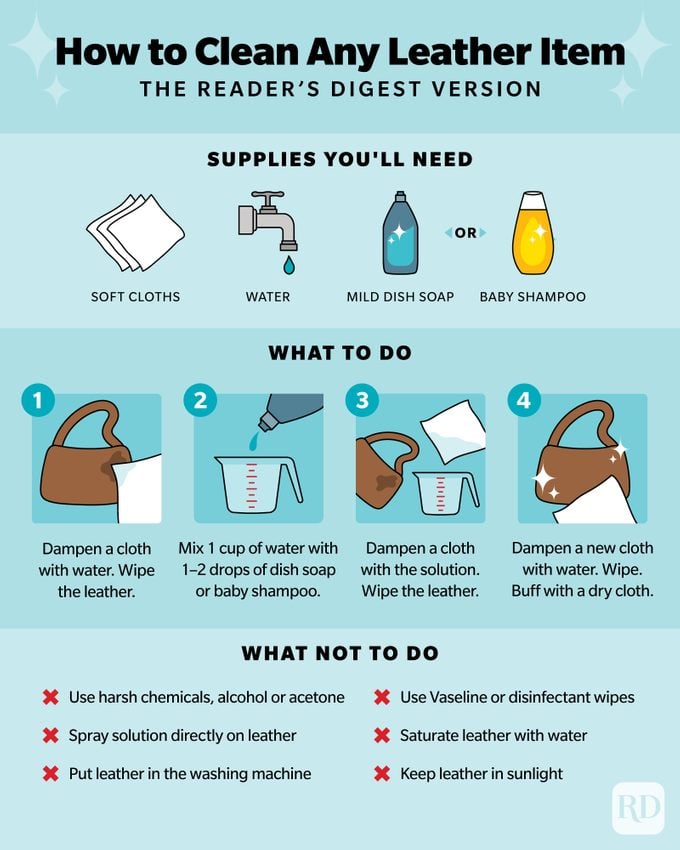
What should you never do when cleaning leather?
Never assume that the bigger the stain or mess, the more product you’ll need. A common refrain from each leather professional I spoke with was that less is more. And that’s because there’s no standard of care, whether you’re cleaning a couch or a jacket.
Gershon points out that unlike textiles, there’s no labeling law for leather, which can make it hard for at-home cleaning. “The Federal Trade Commission (FTC) governs the labeling of textile garments sold in the United States, telling both owners and fabric-care professionals how to clean them,” he says. “With leather, on the other hand, the FTC only requires labeling that discloses the type of leather, but no care instructions besides ‘clean by a leather professional.'”
As you can imagine, leather-care pros have seen it all. Here are some things to avoid so that you don’t damage the leather you’re trying to clean.
- Never put leather in the washing machine.
- Never saturate leather with water. Excess moisture can create darkening and rings.
- Never use a soaking wet cloth. It should only be damp or dry.
- Avoid any and all harsh chemicals, such as alcohol and acetone, which damage finishes and can pull up color.
- Avoid any products or tools that could damage the top coat of the leather. This will not only compromise the protective layer of your leather, but could also cause you to lift color from your leather.
- Avoid placing leather in direct sunlight for prolonged periods.
- Never spray protective products that are propelled by aerosols directly on your leather goods. The propellant can spray out first and stain your leather. Always check directions and begin spraying away from the leather item.
- Never attempt to put water on vintage leather. According to Gershon, it will dry “rock hard” because of decreased lanolin in the leather.
- Never blow dry your leather to get it to dry faster, Gershon cautions. Blow-drying can burn the leather, creating dark spots and cracking.
- Be aware that lighter colors may be more prone to darkening when using certain cleaning products or methods, while darker colors are more resistant to these effects.
How to clean leather with a leather cleaner
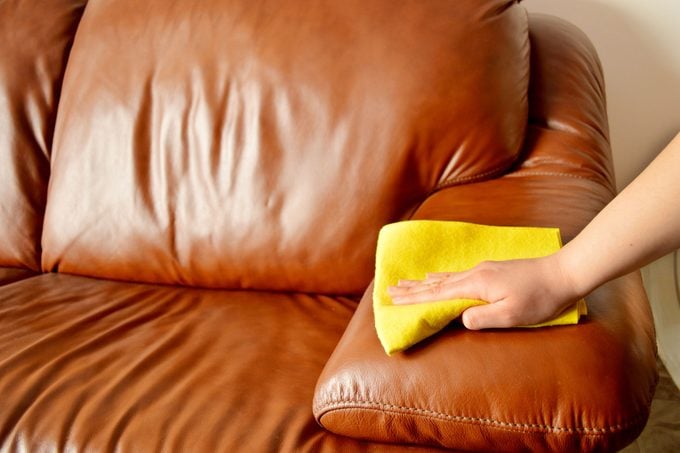
Using a dedicated leather cleaner takes most of the guesswork out of what to use. While I tend to reach for my own homemade, multipurpose cleaning solutions, I appreciate the value of products formulated for a particular purpose—and leather seems like a wise place to put them to use.
According to Jason Jobson, co-owner of Christophe Pourny, a furniture restoration studio and line of leather-care products, when using a leather cleaner, first look at the differences in consistency between each product. A runnier, oil-based product is ideal for getting into cracks and crevices (a good choice for a Chesterfield sofa, for instance), while a cream formula with a waxier base is better for items that need weather protection, such as shoes.
And remember that just because you’re using a product made to clean leather doesn’t mean anything goes. Jeff Schwegmann, owner of Leathercare USA and a fourth-generation leather cleaner, emphasizes the importance of reading and following the directions on the bottle. And as always, less is more. Do not use too much product.
Supplies you’ll need
- Two soft cloths, dry
- Leather cleaner
Directions
- Carefully read the directions on the container of your leather cleaner.
- Apply the product to your cloth, not directly to your leather item.
- Spot test an inconspicuous area, if necessary.
- Rub the product into your leather item in circular motions, making sure to cover the entire area.
- Buff dry with a clean cloth for shine. In some cases, you can skip buffing if you want a matte finish.
How to clean leather with vinegar
Vinegar is a mild cleaner that can safely be used on leather, but the solution should be very diluted. In addition, your cleaning rag should only be damp, a point that all three leather-care experts emphasized repeatedly.
You can mix your solution in either a bowl or a spray bottle. I like the convenience of the spray bottle because you don’t have to worry about water drips or spills, but I also like the bowl option because dunking my rag in the solution releases dirt from the rag periodically as I clean.
Supplies you’ll need
- Three soft cloths
- Warm water
- Distilled white vinegar
- Bowl or spray bottle
Directions
- Mix a solution of 1/4 cup of distilled white vinegar per 1 cup of water in a bowl or spray bottle.
- Dip the cloth into the bowl and wring it so the cloth is only slightly damp. Or spray your solution on your cloth (not onto your leather item or furniture).
- Wipe the leather with the damp cloth, adding fresh solution to your cloth as necessary.
- Wipe the leather with another cloth that’s slightly damp with only clean water.
- Buff the leather dry with your third cloth.
How to clean leather with soap
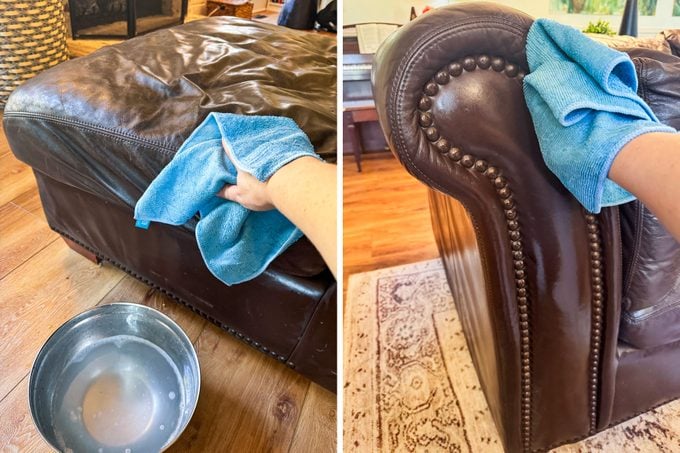
If you’re cleaning leather shoes or the dirty outside of a handbag, for instance, you may need a bit more cleaning power. You can make a mild solution of water and either a mild dish soap or baby shampoo to clean your leather. Our family room couch, where we enjoy movie nights (with snacks) and where our dogs sleep every night, definitely needs regular cleaning with more than just water.
Schwegmann says that while dish soap is a great cleaning agent and can be effective when cleaning leather, it’s crucial to dilute it heavily. Dish soap can be so concentrated that if you use it straight, it can pull out the color in your leather items, he says.
Baby shampoo is also a good option for cleaning leather with soap. According to Schwegmann, baby shampoo tends to be pH neutral and therefore rinses easily. Since over-use of product is a common problem when cleaning leather, a solution that rinses easily is ideal. He suggests finding a baby shampoo that’s free of fragrances, aloe and any oils.
Supplies you’ll need
- Three soft cloths
- Warm water
- Dish soap or baby shampoo
- Bowl or spray bottle
Directions
- In a bowl or spray bottle, mix 1 cup of warm water with 1 to 2 drops (maximum) of either dish soap or baby shampoo.
- Dip the cloth in the solution and squeeze so it’s only damp. Or spray the solution on your cloth. Never spray directly on the leather.
- Wipe the leather with the damp cloth, adding fresh solution to your cloth as necessary.
- Wipe the leather with another cloth that’s slightly damp with only clean water.
- Buff the leather dry with your third cloth.
How to clean white leather
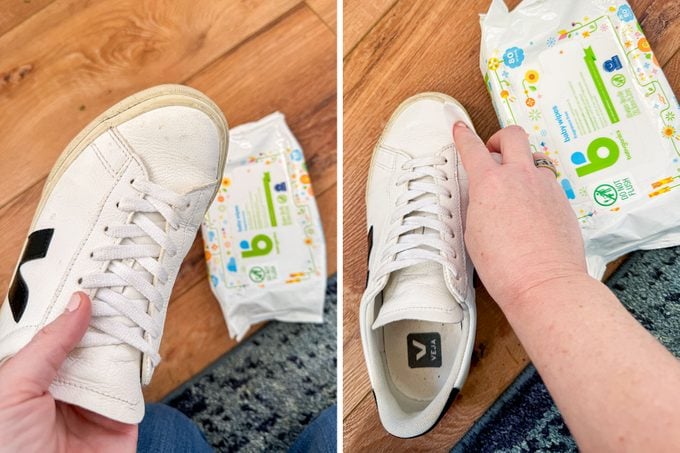
White leather is prone to showing any kind of darkening or staining because of its light color, so extra care must be taken when cleaning it. While standard cleaning methods are fine for finished white leather, take extra care to spot test before using a cleaning method or product on the entire leather item.
White unfinished leather, which Schwegmann says is trending, is the trickiest to clean because it doesn’t have a protective coating. Dirt and stains will absorb and show, he says. “Be selective of where you wear it and where you hang it,” he says, as “cleaning beats them up.”
Another important point to keep in mind, according to Schwegmann, is to follow directions when using any kind of spray on leather goods, especially if the leather is white. “Never spray products with aerosol directly on the leather,” he cautions. When you depress the nozzle, “start the first burst in another place” or you could be left with a dark, greasy mark on your leather.
Supplies you’ll need
- Baby wipes
- Three soft cloths
- Warm water
- Dish soap or baby shampoo (optional)
- Bowl or spray bottle
Directions
- Gently wipe away dirt with a baby wipe. This is an especially good option for white leather shoes, according to Schwegmann.
- In a bowl or spray bottle, mix a solution of 1 cup of water with 1 to 2 drops of mild dish soap. Or just stick to plain water.
- Dampen your cloth with the solution or water, making sure the cloth is minimally damp.
- Wipe your leather item with your damp rag.
- If you used a soap solution, follow with a rag only slightly damp with clean water.
- Buff dry with your third dry cloth.
How to clean suede or untreated leather
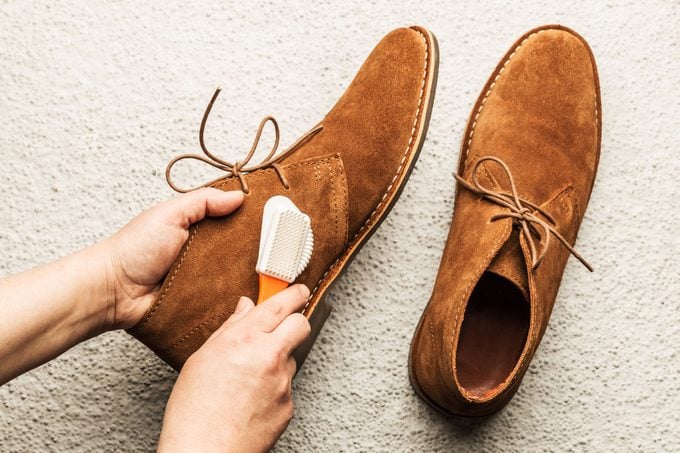
For best results, suede shouldn’t be cleaned with anything but a suede cleaner, as moisture can permanently mar suede. When it comes to unfinished leather, be aware that it will absorb anything you put on it more easily than finished leather, making it more susceptible to showing effects from any leather-cleaning efforts. That means, in general, you’ll only want to wipe unfinished leather with a soft cloth or dry soft brush.
If you’re unsure whether your leather is treated or untreated, find an inconspicuous area and place a drop of water on it. If the water absorbs into the leather right away, it’s unfinished, but if it beads up, your leather has a finish or topcoat of some kind.
How to remove stains from leather
When it comes to removing stains from leather, there are two main things to keep in mind: address the stain as soon as possible, and don’t overdo it. Schwegmann points out that if you’re able to wipe up something that would stain right away, the stain will likely not be permanent. On the other hand, he points out, leather is a protein, and protein stains can become a permanent part of the leather itself if the issue isn’t addressed in a timely fashion.
Treating stains too aggressively can also cause more harm than good. Using too much product, the wrong product or rough scrubbing can damage your leather more than the original stain did. You could damage the protective coating, cause stains to spread or even accidentally pull color out of the leather. Your best bet to remove stains is to attempt gentle techniques first. If those don’t work, take your item to a leather-cleaning professional or, for large furniture, have a professional come to your home.
And remember, when it comes to leather, stains, marks or scratches might just be a part of the journey. As Jobson points out, part of owning leather is embracing the patina that develops. Marks that can’t be removed, he says, tell the story of your piece, and that’s OK.
Messes that could stain should always be addressed as quickly as possible. Wipe with a baby wipe or a damp rag. Oily messes should be treated as soon as possible with a sprinkle of baking soda to absorb the mess.
How to remove water stains from leather
While it’s sometimes possible to remove a water ring, it isn’t always. If you cannot remove a water ring using the steps below, take your item to a leather-care professional. According to Jobson, they may be able to darken the entire piece to disguise the ring.
- Remove the moisture by blotting dry with a rag.
- Let the item dry before you do anything else.
- If a ring remains, try a leather serum or cream all over the leather.
How to remove oil stains from leather
Dark stains can come from any number of things, and it isn’t always easy to know how a stain occurred. A ring is the telltale sign of a water stain, which should be addressed according to the steps above. An oil stain, on the other hand, can be addressed with the steps below. Remember to never use harsh methods or products when addressing stains (and keep in mind that leather patinas over time—and that’s OK).
- Sprinkle the area with baking soda.
- Allow it to sit for about 30 minutes.
- Wipe away the baking soda with a slightly damp cloth.
- Follow with a leather cleaner, adhering to the instructions on the packaging.
How to remove ink stains and marker from leather
Ink stains and marker are notoriously hard to remove from leather, and if not addressed soon after they happen, they can become permanent. Schwegmann puts it bluntly: “It’s only luck if it comes out,” he says. And while sometimes, you can get lucky, he tempers expectations. “Ink becomes part of the skin.” His advice? Get a professional involved.
Jobson agrees that ink stains are especially difficult to address because they are notorious for spreading. “Ink is horrible in that it spreads, and you could end up blurring the spot,” he says. To try to treat ink stains at home without making the issue worse, there are a few methods Jobson recommends, including using baking soda or Castile soap.
- Blot the stain with a cotton ball or rag to absorb as much ink as you can.
- If using baking soda, sprinkle on the stain and let it sit for about half an hour before wiping up the baking soda with a soft rag.
- If using Castile soap, mix a couple of drops into 1 cup of water. Dip a toothbrush in the solution and scrub the ink stain gently in small circles.
How to remove road salt from leather
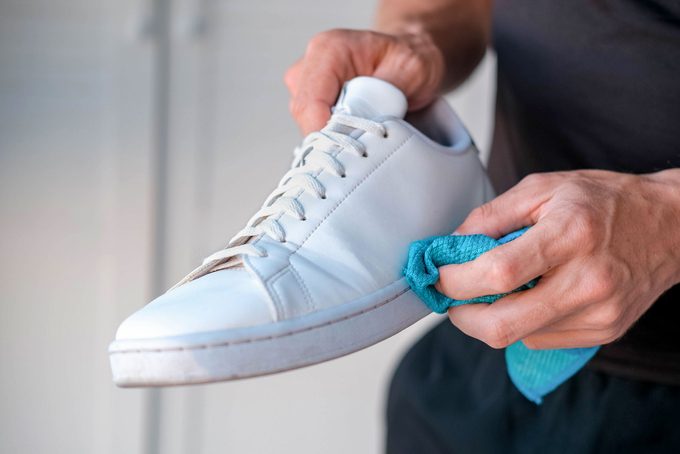
Road salt can kick up onto your leather shoes while you’re walking and sometimes cause stains. Here’s what Gershon recommends.
- For a mild solution, mix 1 to 2 drops of dish soap or baby shampoo per 1 cup of water.
- Dip a cloth in the solution and wring it out so it’s only damp.
- Wipe the leather with the damp rag, being mindful of passing over all the leather so you don’t end up with water rings.
- If you do end up with rings, try a leather-care product like saddle soap to loosen up the rings and work them out of the leather.
How to condition leather
Not only can conditioning your leather prevent some stains, it’s a key component to maintaining leather. Conditioning leather bags and shoes applies a coating that helps make your leather accessories weather resistant. Similarly, conditioning your leather furniture keeps the leather supple and beautiful and can protect it from dirt, spills and stains.
Products available on the market include conditioning wipes, oils, lotions and kits. Schwegmann is a fan of leather conditioning kits, which he recommends applying once a year. If you’re cleaning a leather sofa or chair, make sure to find one your leather seller recommends. “You want one that says ‘furniture,'” he emphasizes. When it comes to conditioners, Gershon prefers a good leather lotion with lanolin.
Opinions differ on the importance of using separate cleaning and conditioning leather-care products. Schwegmann says that leather-care cleaners are most effective when used separately from conditioners. He worries that repeatedly using a combined product on soiled leather can cause wax to build up over the stain.
Jobson has a different view. “Leather-care products clean and condition,” he says, referring to the line he and his partner, Christophe Pourny, author of The Furniture Bible, co-created. Conditioning the leather is a by-product of cleaning it, Jobson says. For example, “You can get salt stains off shoes in the winter time with leather cream. If you’re cleaning, you’re getting the conditioning with it and vice versa. Leather is usually tanned quite well, even if naturally, and it’s rare that you’re treating raw leather, so any of the formulas will pick up the soil.”
Supplies you’ll need
- Leather conditioning wipes or leather conditioning product
- Soft cloth
Directions
- Read and follow the package instructions.
- Test on an inconspicuous area.
- If not using wipes, apply the product to your cloth rather than directly to the leather.
- Buff into your leather with a circular motion.
- If instructed, buff dry.
How often should you clean and condition leather?
This differs for cleaning versus conditioning and depends on how often you use your leather. In general, you should condition your leather every three months, according to Schwegmann. Cleaning should happen much less often, as leather items are not designed to withstand excessive cleaning. Schwegmann says a rough frequency of “no more than once a year, but three years is better. Leather coats and accessories are not designed to be cleaned repeatedly.”
FAQs
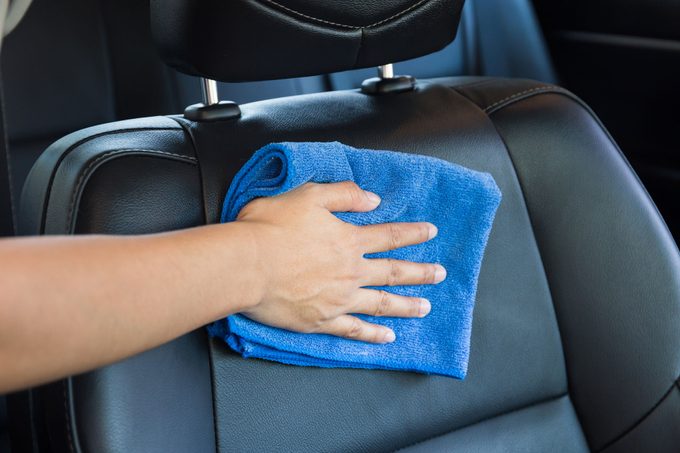
Can you clean 100% pure leather?
Yes, you can clean 100% pure leather. Most leathers have a top coat or other protective finish and can be cleaned with a damp cloth or a mild solution of water and either dish soap or baby shampoo. Alternatively, you can use a dedicated leather-cleaning product.
Unfinished leather, on the other hand, requires extra precautions. Because unfinished leather doesn’t have a coating, it will absorb water as well as leather cleaner and conditioner.
What is the best way to clean the leather interior in your car?
The best way to clean your car interior is to select a dedicated product made for cleaning leather car interiors. “They make so many products in the automotive store,” says Schwegmann. “You run into more problems when you use home remedies and don’t test them first, or if you use too much product.” When it comes to cleaning the leather interior of your car, you can clean first, condition next and then dry buff with a cloth, he says.
Can you use Vaseline to clean leather?
No, don’t use Vaseline to clean leather. “Vaseline is an old wives’ tale,” says Schwegmann. People used to put Vaseline on leather motorcycle jackets, Schwegmann says of where it comes from. And while he says it’s OK if you really buff it out, the jacket “will be greasy forever.” While our skin absorbs Vaseline, a “dead hide” will not absorb Vaseline the same way.
Can you use wet wipes to clean leather?
Yes, you can use baby wipes, which are gentle, but don’t ever use disinfecting wipes to clean your leather. “If they’re safe for a baby’s bottom, then they’re safe for leather.” Disinfecting wipes, on the other hand, contain either alcohol or other ingredients that are too harsh to use on leather. These kinds of harsh ingredients can not only damage the coating of your leather, but could even pull out the color.
Why trust us
At Reader’s Digest, we’re committed to producing high-quality content by writers with expertise and experience in their field, in consultation with relevant, qualified experts. For this piece, Shifrah Combiths tapped her experience as a cleaning writer. Then fabric-care and stain-removal expert Mary Marlowe Leverette gave it a rigorous review to ensure that all information is accurate and offers the best possible advice to readers. For this piece, we relied on reputable primary sources, including cleaning and health experts and reputable organizations. We verified all facts and data and backed them with credible sourcing, and we will revisit them over time to ensure they remain accurate and up to date. Read more about our team, our contributors and our editorial policies.
Sources:
- Jeff Schwegmann, owner and operator of Leathercare USA; phone interview, Jan. 30, 2024
- Bruce Gershon, owner and operator of Arrow Leathercare Services; phone interview, Jan. 30, 2024
- Jason Jobson, co-owner of Christophe Pourny; phone interview, Jan. 31, 2024

